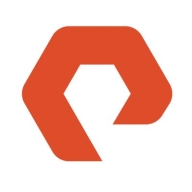


NetApp AFF and Dell Unity XT are two competitive storage solutions. NetApp AFF holds an edge in performance, but Dell Unity XT shines in scalability and comprehensive features.
Features:NetApp AFF reviews commend its lightning-fast performance, seamless cloud service integration, and efficient data management. Dell Unity XT receives positive feedback for robust scalability, advanced data services, and flexible storage options.
Room for Improvement:Users suggest NetApp AFF could benefit from a more intuitive configuration process, improved support documentation, and a better UI. Dell Unity XT could enhance its data migration tools, streamline patch updates, and improve maintenance functionalities.
Ease of Deployment and Customer Service:NetApp AFF is praised for straightforward deployment but needs better guidance and support during initial setup. Dell Unity XT is recognized for ease of deployment in large-scale environments and responsive customer service.
Pricing and ROI:NetApp AFF users find the initial setup costs to be high but justify it with excellent long-term ROI due to superior performance. Dell Unity XT users appreciate competitive pricing and quick return on investment, citing the product's extensive features.



Pure Storage FlashArray//X is the world’s first enterprise-class, all-NVMe flash storage array. It represents a new class of storage – shared accelerated storage, which is a term coined by Gartner – that delivers major breakthroughs in performance, simplicity, and consolidation.
Dell EMC Unity XT is one of the best all-flash storage arrays on the market today. Dell EMC Unity XT arrays are designed for performance, optimized for efficiency, and built for a multi-cloud world. In addition, they support digital transformation, enabling businesses to reach the full potential of their data capital quickly and easily. Dell EMC Unity’s All-Flash and Hybrid Flash storage platforms provide the performance, efficiency, enterprise-class software, and virtualization integrations required for running a wide range of virtualized applications.
Dell EMC Unity XT Features
Dell EMC Unity XT has many valuable key features, including:
Dell EMC Unity XT Benefits
Some of the benefits of using Dell EMC Unity XT include:
Reviews from Real Users
Below are some reviews and helpful feedback written by Dell EMC Unity XT users.
A Systems Engineering Manager at a manufacturing company says, "It is definitely one of the most robust, solid, well-performing products that I have dealt with. It is set it and forget it, which is pretty amazing." He also mentions, “We can do both block and file storage on one unit without purchasing a separate device.”
Peter S., Senior Technical Specialist at a healthcare company, states, “The most valuable feature is reliability. At the end of the day, it just runs. This solution is easy to work with and easy to maintain.”
PeerSpot user Melvin T., Senior Systems Engineer at Prosperity Bank, explains that the solution is “easy to use and we can add LUNs or space without interruption to end-users. We're able to access it from just about anywhere, as long as we have access to a browser. That feature is really neat because sometimes we will go to a different data center or a different site, and if we need to access it to see a LUN or to see any type of storage, we can do that. That's one of the big takeaways with Unity."
The NetApp A-Series and C-Series are AFF storage arrays that deliver high performance, scalability, and simplified data management for a wide range of workloads. They are designed for organizations that need to improve the performance and agility of their applications, while also reducing costs and complexity.
NetApp A-Series and C-Series feature a scale-out architecture that can be scaled to meet the needs of your growing business. They also support a wide range of built-in data protection and data security features, including snapshots, replication, disaster recovery, and autonomous ransomware protection.
AFF A-Series all-flash systems deliver industry-leading performance, density, scalability, security, and network connectivity.
AFF C-Series systems are suited for large-capacity deployment as an affordable way to modernize your data center to all flash and also connect to the cloud.
NetApp AFF Benefits
NetApp AFF Features
Reviews from Real Users
NetApp AFF stands out among its competitors for a number of reasons. Two major ones are its high performance and simplicity. PeerSpot users take note of the advantages of these features in their reviews:
PeerSpot user and Storage Administrator, Daniel Rúnar Friðþjófsson, comments “AFF has helped to simplify our infrastructure, while still getting very high performance for our business-critical applications. Having all these things working well on one solution is really good. We run this as the backbone for both Hyper-V and VMware as well as an archive location for Rubrik. So, it is great having one solution that can do it all.
Because of the ease of it all, you have a highly tunable, high-performance storage system that alleviates a lot of problems. With its ease of management, you can quickly get your work done and go onto the next thing on your list.”
Additionally, Mohan Reddy, Sr. Technology Architect at a Pharma/Biotech company comments on how “NetApp's ONTAP data management software has also made tasks simpler for us. There's no question about that. It has helped us run operations very quickly, saving us a lot of time. Before ONTAP, we used to spend a long time doing regular operations, but with the latest version of the tool, our day-to-day operations are much quicker and easier.”
We monitor all All-Flash Storage reviews to prevent fraudulent reviews and keep review quality high. We do not post reviews by company employees or direct competitors. We validate each review for authenticity via cross-reference with LinkedIn, and personal follow-up with the reviewer when necessary.